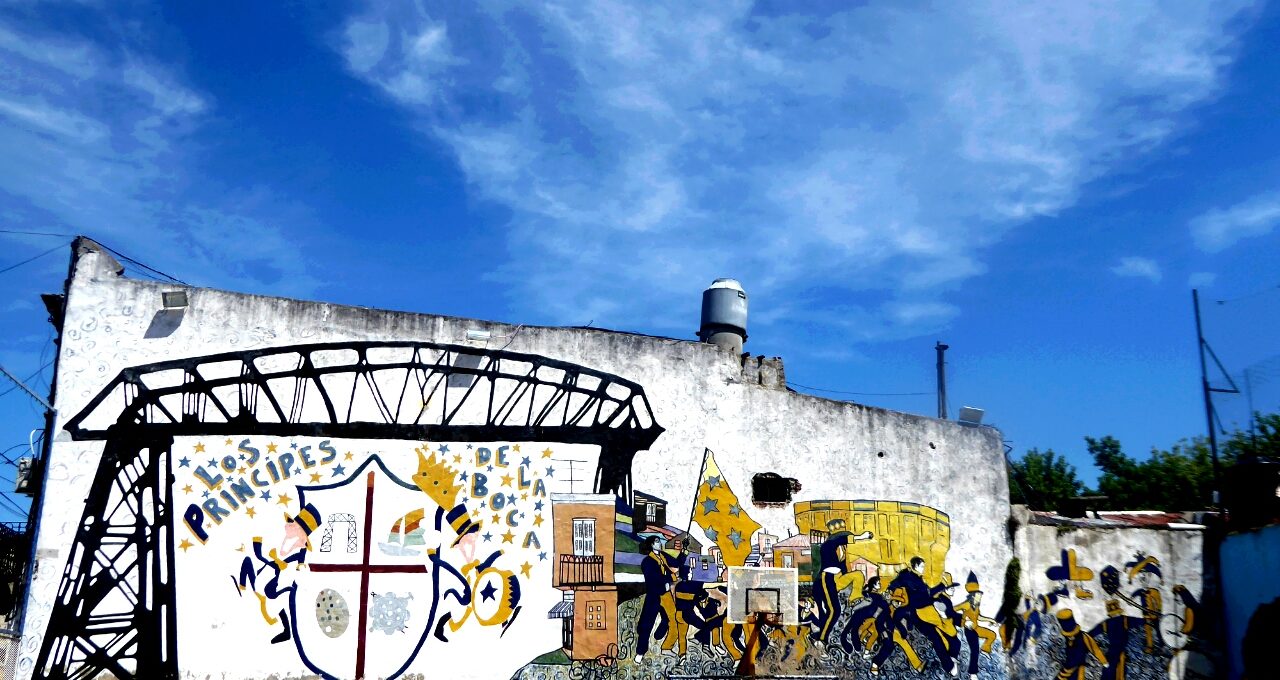La Boca is a barrio (neighbourhood) in Buenos Aires with a riveting history connected to tango, football and politics. Founded as a port town,it was settled mainly by Genoese immigrants from Italy beginning in the 1830s . At the turn of the 19th century, the port moved northward to Puerto Madero. La Boca fell in to decline as it lost its economic importance. This also made it the most affordable place for new immigrants to live in. For visitors, a walk around the Caminito and La Bombanera ( the Boca Juniors’ stadium) will allow one to trace the colourful past of this town.

Visitors will arrive by one of the city’s reliable collectivos (bus) to the bus stop just outside Caminito. As you get off the bus stop, you will see a statue of a man looking over the Caminito with pride on your left. This is Benito Quinquela Martin, famed Argentine painter and philantropist. He is credited for being responsible for the regeneration of the area when he began to use the buildings in the area as his canvas -giving the area its colourful identity.

As you looked towards your right, you will see the colourful buildings that have come to characterised the area. The immigrants in the past built their houses using metal sheets scavenged from the port. In the 1950s, Martin and a group of Argentinian artists brightened up the area with their art. Walk down the street, Magallanes and you will find many restaurants with tango dancers.

As you take a moment to appreciate the intricacy of the tango, try to imagine tango as it began – a dance between male couples. La Boca had an overwhelmingly male population in the 19th century. Out of 10 people, there was 1 woman and 9 men. Therefore, men would practice tango with each other. This, coupled with the risque nature of tango contributed to it being seen as immoral by the authorities.

Above the restaurants, you will see the buildings that served as tenement houses for the new immgirants. Several workers would rent the same bed – a common practice for poor immigrants all over the world in the 19th century. The tenement houses have been turned into arts and crafts shops on this street -offering you an opportunity to have a glimpse into the past. Look for the Bondeneon player playing Argentinian folk songs in one of the compunds.

As you approach the end of the street, you will see a fence demarcating the end of the ‘tourist zone’. Take a right here and you will find the delightful Museo Conventillo De Marjan Grum to your left and delicios asado (grilled meat) to your right at Restaurant Gran Paraiso. Museo Conventillo Marjan Grum is run by Slovenian artist, Marjan Grum. The building is instantly recognisable by the mural painted in art nuevo style depicting the artist’s life story. His family had fled to Austria where his family lived in a refugee camp. The family migrated to Argentina after World War II where Marjan Grum established himself as an artist.

An asado break at Gran Paiso will inform you of why Argentinean beef is considered one of the best in the world. Continue down the street and turn right into Gral Greogrio Araoz de Lamadrid. Another right turn down an alley leads you proper into Caminito which is an art market featuring La Boca’s resident artists.

Head back to Gral Gregorio Araoz de Lamadrid and continue to the end of the street. A huge mural commemorating ” Republic de La Boca” is painted on the wall. Republic de La Boca was founded by La Boca residents in 1882. Tired of receiving low wages, they seceeded from Argentina and raised the Genoese flag depicted in the mural. A letter was sent to the king in Italy informing him of his new colony. However, before the king could receive the letter, the president Julio A.Roca ripped off the flag. The republic lasted for three days.


Take a left turn from here to head to the mecca of Boca residents, La Bombanera. On the way there, you will notice a shrine dedicated to Robin Hood-esque folk hero, Gauchito Gil. Gauchito Gil is revered as a saint for when he was executed for refusing to fight in a civil war, he predicted that his executioner’s son would be ill. The executioner’s son was cured after the executioner to pray to Gauchito Gil.
Follow the train tracks and the crowd to the Boca Juniors stadium. Founded in 1905, Boca Juniors has gone on to become one of the world’s most reknowned football clubs. English tours of the stadium are available. However, match tickets are very almost impossible to get as only members of the Boca Juniors club can purchase them. There is a 16 years waiting list to get into the club.
When you are ready to leave, follow the train tracks back to the Caminito which will lead you back to the bus stop.
Practical tips for visitors :
– There is no subway to the area but there are many busses that go there from town.
– Do not wear the jersey of rival team, River Plate when visiting.
– Locals advice to not venture out of the tourist areas as the chances of getting robbed are rather high.
– The area is busy up until 6pm. Shops and restaurants close at 6pm so the best time to visit is in the afternoon.

0 comments on “Walking Guide to La Boca”